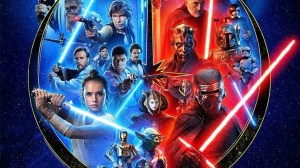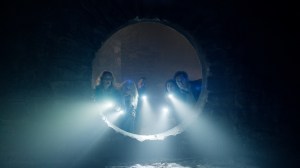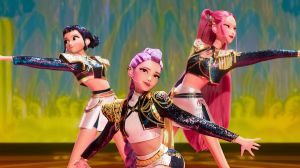This week’s episode of Star Trek: Picard, “Fly Me to the Moon,” was a Star Trek: The Next Generation reunion. Patrick Stewart leads the series, and John de Lancie is back as Q. The episode also introduces Next Generation’s Brent Spiner in his latest role, Adam Soong. Jonathan Frakes directed the episode, not only reuniting with his former TNG co-stars but also getting another opportunity to direct the Borg Queen, an idea that originated in the film Star Trek: First Contact, which he also helmed.
Videos by ComicBook.com
ComicBook.com had the opportunity to speak with Frakes over the phone about filming the reunion while COVID-19 restrictions were still in place. We also touched on his approach to this new Borg Queen and what it’s like shooting a Star Trek episode set in the present day.

A lot is going on in this episode: Brent Spiner is back, it’s 2024, and a lot is happening. What was your first impression when you got this script, looked it over, and saw all of these things in there?
Jonathan Frakes: Well, I thought it was quite ironic that we’re revisiting the Borg Queen with the Locutus and Seven in tow; that Brent Spiner is yet again, another layer, another Soong in the Soong/Lore/Data/B-4 family rainbow that he represents for that whole world.
Also, having de Lancie back as Q, Q is my favorite nemesis in this whole Star Trek Next Gen world.so, I’m always grateful to have John in a show with me, the natural shorthand that comes from working with your old friends again. I was just talking about the day that we were doing the diner scene, that restaurant with Q and Soong. To spend the day with Brent and de Lancie, not only on camera and the shorthand and comfort that the three of us have together, and off-camera to have lunch together and to catch up and to shmooze and shoot the shit, it was really as if no time had passed at all. I know that seems corny, but it’s quite, quite true.
You and Spiner both were involved in Picard‘s first season, but this is the first time you’ve worked directly together on the series. Was there a celebratory, TNG reunion feel to filming with the two of you and de Lancie there, or did the COVID protocols put a damper on that?
The COVID protocols have put a damper on production and show making and television making in a way that I’m not sure people understand it has. In my experience of the last two years, a lot of the fun of what we do for a living has been taken out of it by the necessary but brutal COVID protocols, both in terms of time, communication, access, the masks, the shields, the testing, the limitations, the numbers, just freedom has been cut back. I get it’s important, but I’m really hopeful that we are seeing the end of this long, not very exciting road that we’ve been on.
I was going to ask if there were any particular challenges you faced with this episode that you haven’t before, but it sounds like the COVID protocols are the thing.
Yeah, I had gotten used to it. They’re very strict in Canada. I had been up and doing Discovery, and I was working on another show called Astronauts when the COVID really hit, we shut down. But I get it, and I think our industry has really been an excellent example of how we can continue forward carefully. I’m very proud of how well we’ve done. But, it changes the process, and the process for me, the way I work, involves a certain freedom of expression and playfulness that I try to bring to the set. A lot of that was squelched by the lack of freedom of movement that we all have.
But, having said that, the callback to First Contact with the Borg Queen, the wonderful Annie Wersching and stealing some shots that we had done when [Matthew F.] Leonetti was the cinematographer on that. I went and I do this one with Jimmy Lindsey, and he and I had talked about how we wanted to tackle the Borg Queen. So, we did a lot of Dutching as we had on that film that I think, either subliminally or otherwise, the audience will remember and feel if their fans of that particular storyline.
I also think any time we talk about Picard, in addition to Patrick’s obvious talent, Alison Pill is an astonishing actor and noteworthy in that she can really do anything. Great comedy, which is you can’t teach, incredible, heartbreaking ability to let you into her soul. I’m a huge fan.
So, this episode, we start to examine the Seven-Raffi character relationship, which is quite special as well. I think the season has found its rhythm in a way. At least the responses that I’m seeing in social to season two of Picard have been really, really positive.
You mentioned the Borg Queen and the visual callbacks you added to this episode. What would you say is the most significant difference between this version of the Borg Queen and what you were working with during First Contact?
I think that the character that Ron [Moore] and Brandon [Braga] created in First Contact and which was so brilliantly interpreted by Alice Krige is what Annie and I and Terry [Matalas] and Cindy Appel and Akiva [Goldsman] based this Borg Queen on. What has changed, I think for the better, is the blending of the design of James McKinnon’s work and Neville Page, who developed the look of the Borg Queen, and J.Z., Jason Zimmerman, who’s a visual effects supervisor, what he has added, and that with, as I mentioned, what Lindsey and I embraced from the way we shot the Borg Queen.
So, the 2022 version of practical effects, makeup, visual effects, graphic effects, the acting, and the writing being informed all by the earlier version, I think it was, if anything, heightened by all those elements. And Annie brought a new color to it, which I really like. She was surprising in that there’s a certain sarcasm in her work. There’s a certain confidence. The Borg Queen was always confident, but Annie, in spite of the seeming physical restraints, which I thought were fascinating in the way that they were designed, what that suggested, was able to work with incredible authority. I’m a big fan of hers as well.
You’ve filmed plenty of Star Trek, but was there anything special or different in handling this more or less present-day setting of 2024? Does that change how you approach the material at all?
That’s a good question. I think, if anything, it honors what Roddenberry had always tried to do, but it hits it even more on the head, which is, to comment on our current condition through science fiction. So, the inherent racism, that’s in this. The way people are mistreated, the homelessness issues, all these things are in the story and in our face and in our lives and Star Trek, I think, has taken the opportunity to not take a position as much as present the truth to us. As we’re telling a time travel story, we happen to have traveled in time to two years from now. It’s a cautionary tale, if you will, that we’ve got to get our shit together.
I’ve noticed some particularly strong reactions to the 2024 stuff, like the heroes having to beat up some ICE officers to rescue Rios. It sounds like there was no hesitation about handling that material head-on.
No, I think that our writers are very aware of what’s going on in the world, and I thought that it was handled in an exemplary way.
I talked to Patrick Stewart before the season aired, and he talked about one of the things he got to do this season that he hadn’t gotten to do before was play Picard in an actual romantic situation. That’s as opposed to going on, in his words, “a series of dates” in The Next Generation.
[Laughs]
I know she isn’t playing Laris in this episode, but you directed Stewart with Orla Brady in this episode. Did that feel like a new challenge for you, trying to navigate that complicated relationship?
Well, I thought that the tone that we sought is a carryover from the end of Lea [Thompson]’s episode. But the moment they enter Talinn’s apartment, Picard is struggling with trying to understand, embracing, reacting to the romantic feelings he has for Laris. It’s inevitable. I think that was the brilliance of casting Orla in the role of Talinn as well. It’s a very clever way to do this, to suggest that this watcher looks just like Laris and has no idea you who Laris is, but in Picard’s heart, you can’t help but look at her. It informs the scene, layers up the acting in the scene, certainly for Patrick and Orla because Orla has played both characters and needs to deny what she knows about Laris and Patrick is playing the same character and has to wrestle with the idea that they are two different characters.
Lastly, what’s next for you with Star Trek? I believe you’ve said you directed again for the final season of Picard, and then you worked on Strange New Worlds. Are you back for the next season of Discovery?
Yes, and yes, and yes. And I’m grateful for all of it.
This interview has been edited for length and clarity. Star Trek: Picard is streaming now on Paramount+.








